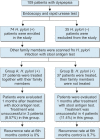Helicobacter pylori Infection among Patients with Dyspepsia and Intrafamilial Transmission
- PMID: 29201737
- PMCID: PMC5578573
- DOI: 10.5005/jp-journals-10018-1177
Helicobacter pylori Infection among Patients with Dyspepsia and Intrafamilial Transmission
Abstract
Introduction: Recurrence is an important problem after Helicobacter pylori infection, and intrafamilial transmission has an important role in recurrence. In this study, we aimed to investigate the significance of intrafamilial transmission for recurrence development after treatment as well as its usefulness in prevention.
Materials and methods: Of the 109 patients who had dyspepsia and underwent endoscopy, 74 patients had H. pylori infection and were enrolled in this study. Infected family members were also detected. Patients were randomly divided into groups I and II, with each group containing 37 individuals. In group I, patients and their infected family members were treated together at the same time. In group II, only the patients were treated. Treatment success was evaluated at the 1st month and evaluation for recurrence was carried out at the 6th month.
Results: Helicobacter pylori infection was detected in 67.8% of the patients with dyspepsia. Two patients in each group did not show up at the 1st month control. Eradication was achieved in 63 of the 70 patients (90.0%) who completed their treatment. After 6 months, patients with successful treatment had no recurrence in any of the 32 patients in group I. There were recurrence in 3 of the 31 patients (9.7%) in group II; however, there was no statistically significant difference between the groups (p = 0.113).
Conclusion: Our study showed that eradication treatment in patients and family members with H. pylori infection resulted in a decrease in the number of recurrences even though it was not statistically significant.
How to cite this article: Yalçin M, Yalçin A, Bengi G, Nak SG. Helicobacter pylori Infection among Patients with Dyspepsia and Intrafamilial Transmission. Euroasian J Hepato-Gastroenterol 2016;6(2):93-96.
Keywords: Dyspepsia; Eradication; Helicobacter pylori; Intrafamilial transmission; Recurrence..
Conflict of interest statement
Source of support: Nil Conflict of interest: None
Figures
Similar articles
-
[A multicenter randomized controlled study of bismuth-containing quadruple therapy followed by Jing-Hua-Wei-Kang in the treatment of patients newly diagnosed with Helicobacter pylori infection and dyspepsia].Zhonghua Yi Xue Za Zhi. 2021 Jul 13;101(26):2060-2065. doi: 10.3760/cma.j.cn112137-20210305-00563. Zhonghua Yi Xue Za Zhi. 2021. PMID: 34275239 Clinical Trial. Chinese.
-
[The clinical significance of GastroPanel in diagnostics of Helicobacter pylori eradication efficiency in patients with dyspepsia with correlation of family history of gastric cancer].Pol Merkur Lekarski. 2013 Sep;35(207):141-7. Pol Merkur Lekarski. 2013. PMID: 24224450 Polish.
-
Effect of Helicobacter pylori eradication or of ranitidine plus metoclopramide on Helicobacter pylori-positive functional dyspepsia. A randomized, controlled follow-up study.Digestion. 2002;66(2):92-8. doi: 10.1159/000065589. Digestion. 2002. PMID: 12428068 Clinical Trial.
-
Indications for treatment of Helicobacter pylori infection: a systematic overview.CMAJ. 1994 Jan 15;150(2):189-98. CMAJ. 1994. PMID: 8287341 Free PMC article. Review.
-
Helicobacter pylori and non-malignant upper gastrointestinal diseases.Helicobacter. 2016 Sep;21 Suppl 1:30-3. doi: 10.1111/hel.12337. Helicobacter. 2016. PMID: 27531536 Review.
References
-
- Cardenas VM, Mulla ZD, Ortiz M, Graham DY. Iron deficiency and Helicobacter pylori infection in the United States. Am J Epidemiol. 2006 Jan;163(2):127–134. - PubMed
-
- Suerbaum S, Michetti P. Helicobacter pylori infection. N Engl J Med. 2002 Oct;347(15):1175–1186. - PubMed
-
- Alarcon T, Martinez MJ, Urruzuno P, Cilleruelo ML, Madruga D, Sebastian M, Domingo D, Sanz JC, Lopez-Brea M. Prevalence of CagA and VacA antibodies in children with Helicobacter pylori-associated peptic ulcer compared to prevalence in pediatric patients with active or nonactive chronic gastritis. Clin Diagn Lab Immunol. 2000 Sep;7(5):842–844. - PMC - PubMed
-
- Brown LM. Helicobacter pylori: epidemiology and routes of transmission. Epidemiol Rev. 2000;22(2):283–297. - PubMed
-
- Czinn SJ. Helicobacter pylori infection: detection, investigation, and management. J Pediatr. 2005 Mar;146(3):21–26. - PubMed
LinkOut - more resources
Full Text Sources
Other Literature Sources
Miscellaneous


